Yesterday, Feb 2, was Ground-hog Day. While I don't want to denigrate the ability of those furry rodent prognosticators across the land in speculating the arrival of spring, perhaps just as importantly, it was another notable day: World Wetlands Day.
There is a worthwhile blog post about wetlands on the Canadian Geographic site, located
here.
Wetlands, and of course the lakes, rivers and streams that they are often associated with, are critical to a lot of life, including yours and mine. In fact the survival of most plant and animal life is dependent to varying degrees, on water.
Here in Chatham-Kent, at the time of settlement, according to a 1987 paper, the landscape was made up of 66% wetland, which includes both marsh and swamp. By 1967, only 5% remained and by 1982, that number had dropped further to 3.7%. I don't have figures for the current status, but I expect we have all seen more wetlands disappear than re-appear on the landscape, and there are continuous threats to those few remaining wetlands. For a municipality with less than 5% natural area, not a lot of that is in wetland form, so it is fair to say that wetlands have declined significantly since 1982.
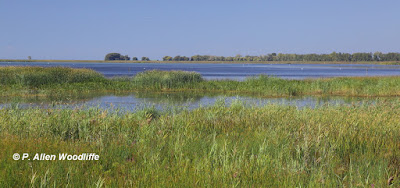 |
| St. Clair area wetlands |
In the early 1970s, 21 participating nations met in Iran, and established the Ramsar Convention, which is more formally known as the Convention of Wetlands of International Importance. Its purpose was to be a treaty for the conservation and sustainable utilization of wetlands for their economic, cultural, scientific and recreational values. Wetland sites were nominated across many of the participatory nations, which typically were some of the most nationally and internationally significant sites.
Some of the wetlands in Chatham-Kent and neighbouring counties were nominated, but currently only two have been adopted as a Ramsar Site. They are Point Pelee National Park and St. Clair National Wildlife Area.
 |
| St. Clair NWA |
The wetlands along the eastern and northern sides of Lake St. Clair are well known for their attraction to migrating and nesting waterfowl. Some of the stats regarding its significance (based on the Ramsar Convention website) are:
- 25% of the North American population of Tundra Swans pass through the area;
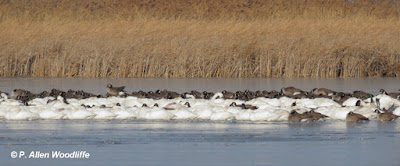 |
| Resting swans and geese |
- over 200,000 Canada Geese pass through the area.
 |
| Tundra Swans, Canada Geese and a few ducks |
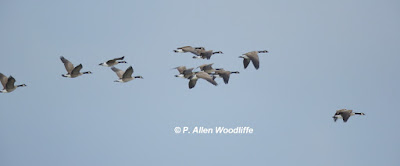 |
| Canada Geese |
- up to 360,000 individual waterbirds pass through the area, including Canvasback, Redhead and Mallards. During the most recent Christmas Bird Count for this area, on January 1, 2016, our one day count of waterfowl totalled over 55,000 birds. In 2007, our one day count totalled over 95,000 birds!
 |
| Diving ducks |
 |
| Canvasback |
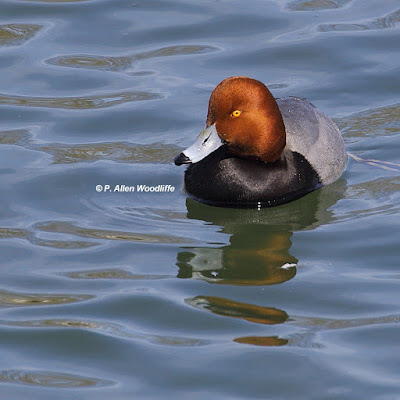 |
| Redhead |
In addition there are numerous species of wildlife besides waterfowl as well as plants that are dependent on these vast wetlands, including many species at risk such as Swamp Rose Mallow, where at times, can be incredibly profuse as this next image shows. The Canadian range of this species is largely limited to the more significant wetlands of extreme southwestern Ontario.
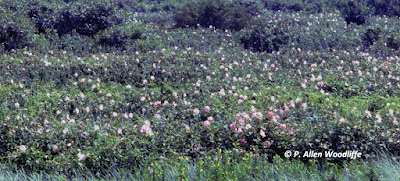 |
| A lot of Swamp Rose Mallow |
 |
| Swamp Rose Mallow |
At the opposite extreme of the province is one of the largest wetland complexes in Canada: the Hudson Bay Lowland. Polar Bear Provincial Park is a huge part of the Hudson Bay Lowland with an area of almost two and a half million hectares, and is Canada's second largest Ramsar site. (The largest is the Queen Maud Gulf in the NWT, which encompasses over 6 million hectares). I was privileged to have spent several weeks in Polar Bear PP doing some wildlife surveys in the early 1990s. It is an incredible place.
The numbers of shorebirds and waterfowl are amazing. For example, on migration, more than one million Snow Geese pass through, and some breed here in huge colonies.
 |
| Blue phase Snow Goose with young |
During migration, the area supports almost the entire Arctic population of Red Knot.
 |
| Red Knot (Black-bellied Plover in background) |
It also supports the entire Arctic breeding population of Marbled Godwit.
 |
| Marbled Godwit |
 |
| Marbled Godwits |
We found Parasitic Jaegers nesting, as well as Pacific Loons.
 |
| Parasitic Jaeger |
 |
| Pacific Loon |
Semipalmated Plovers were nesting close to our camp, and Bonaparte's Gulls were nesting in some of the spruce trees.
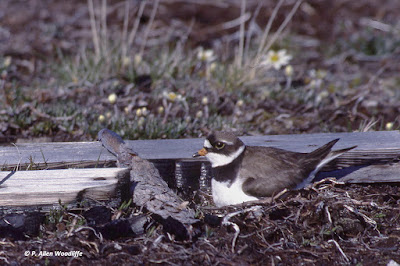 |
| Semipalmated Plover |
 |
| Bonaparte's Gull |
In spite of the recognition of these internationally significant wetlands, so many other significant wetlands of southwestern Ontario have been lost, or are threatened and may be gone tomorrow, or next year. These losses are attributed to our economic development of the area, including agriculture and urbanization. We are all at least partially responsible, and the decline in habitat quality and species diversity continues. Yet I read just today of a prominent spokes person for the industry stating that to demonstrate the environmental responsibility of his industry, the evidence is in the increasing numbers of frogs, birds and other animal populations on the landscape.
Huh???
No examples were provided, because to this person, it was evident by just looking around. I'm not really sure what that person was looking at, however, as the overwhelming evidence is exactly the opposite. Our native populations of flora and fauna have been in decline for decades, and show no signs of letting up. In fact the number of officially, legally
Rare, Threatened and Endangered Species has never been higher, and there are dozens and dozens of other species waiting to be evaluated to determine their status. The only thing that is increasing on the landscape is the abundance of non-native invasive species. And that will be discussed in another post.

























The only thing increasing on the landscape is non-native species and ... wind turbines !
ReplyDeleteRight on....unfortunately. Up to another 110 turbines have been approved by C-K council in recent months, bringing the total to.....well over 400??
Delete